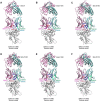Computational redesign of Beta-27 Fab with substantially better predicted binding affinity to the SARS-CoV-2 Omicron variant than human ACE2 receptor
- PMID: 37726329
- PMCID: PMC10509195
- DOI: 10.1038/s41598-023-42442-1
Computational redesign of Beta-27 Fab with substantially better predicted binding affinity to the SARS-CoV-2 Omicron variant than human ACE2 receptor
Abstract
During the COVID-19 pandemic, SARS-CoV-2 has caused large numbers of morbidity and mortality, and the Omicron variant (B.1.1.529) was an important variant of concern. To enter human cells, the receptor-binding domain (RBD) of the S1 subunit of SARS-CoV-2 (SARS-CoV-2-RBD) binds to the peptidase domain (PD) of Angiotensin-converting enzyme 2 (ACE2) receptor. Disrupting the binding interactions between SARS-CoV-2-RBD and ACE2-PD using neutralizing antibodies is an effective COVID-19 therapeutic solution. Previous study found that Beta-27 Fab, which was obtained by digesting the full IgG antibodies that were isolated from a patient infected with SARS-CoV-2 Beta variant, can neutralize Victoria, Alpha (B.1.1.7), Beta (B.1.351), Gamma (P.1), and Delta (B.1.617.2) variants. This study employed computational protein design and molecular dynamics (MD) to investigate and enhance the binding affinity of Beta-27 Fab to SARS-CoV-2-RBD Omicron variant. MD results show that five best designed Beta-27 Fabs (Beta-27-D01 Fab, Beta-27-D03 Fab, Beta-27-D06 Fab, Beta-27-D09 Fab and Beta-27-D10 Fab) were predicted to bind to Omicron RBD in the area, where ACE2 binds, with significantly better binding affinities than Beta-27 Fab and ACE2. Their enhanced binding affinities are mostly caused by increased binding interactions of CDR L2 and L3. They are promising candidates that could potentially be employed to disrupt the binding between ACE2 and Omicron RBD.
© 2023. Springer Nature Limited.
Conflict of interest statement
The authors declare no competing interests.
Figures




Similar articles
-
Computational redesign of Fab CC12.3 with substantially better predicted binding affinity to SARS-CoV-2 than human ACE2 receptor.Sci Rep. 2021 Nov 12;11(1):22202. doi: 10.1038/s41598-021-00684-x. Sci Rep. 2021. PMID: 34772947 Free PMC article.
-
Computational Design and Experimental Validation of ACE2-Derived Peptides as SARS-CoV-2 Receptor Binding Domain Inhibitors.J Phys Chem B. 2022 Oct 20;126(41):8129-8139. doi: 10.1021/acs.jpcb.2c03918. Epub 2022 Oct 11. J Phys Chem B. 2022. PMID: 36219223
-
Human serum from SARS-CoV-2-vaccinated and COVID-19 patients shows reduced binding to the RBD of SARS-CoV-2 Omicron variant.BMC Med. 2022 Mar 3;20(1):102. doi: 10.1186/s12916-022-02312-5. BMC Med. 2022. PMID: 35236358 Free PMC article.
-
Interactions of angiotensin-converting enzyme-2 (ACE2) and SARS-CoV-2 spike receptor-binding domain (RBD): a structural perspective.Mol Biol Rep. 2023 Mar;50(3):2713-2721. doi: 10.1007/s11033-022-08193-4. Epub 2022 Dec 23. Mol Biol Rep. 2023. PMID: 36562937 Free PMC article. Review.
-
Passive Immunotherapy Against SARS-CoV-2: From Plasma-Based Therapy to Single Potent Antibodies in the Race to Stay Ahead of the Variants.BioDrugs. 2022 May;36(3):231-323. doi: 10.1007/s40259-022-00529-7. Epub 2022 Apr 27. BioDrugs. 2022. PMID: 35476216 Free PMC article. Review.
References
-
- Matheson NJ, Lehner PJ. How does SARS-CoV-2 cause COVID-19? Science. 2020;369:510–511. - PubMed
Publication types
MeSH terms
Substances
Supplementary concepts
LinkOut - more resources
Full Text Sources
Medical
Miscellaneous

